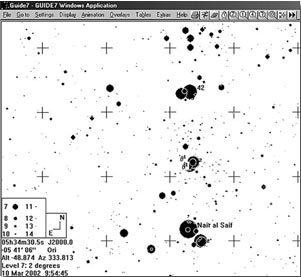Orion Nebula Images
Using the photographic 5-inch refractor, we have experimented mostly with Fujichrome 400 film. The image below was obtained with a 30-minute exposure. The refractor is mounted on the 20-inch reflector, which serves as a tracking platform in this instance, and a guide star was chosen, with small corrections to the tracking. The transparency was scanned on a flatbed scanner with a transparency adaptor (with backlight), which allows scanning 120-size negatives or transparencies.
 The Orion Nebula (Messier 42). The famous Orion Nebula, in the winter sky, is an area in our Milky Way with formation occurring now. This view shows the correct orientation on the sky (see the corresponding sky chart below).
The Orion Nebula (Messier 42). The famous Orion Nebula, in the winter sky, is an area in our Milky Way with formation occurring now. This view shows the correct orientation on the sky (see the corresponding sky chart below).
This object (and other celestial objects) cannot be seen by just looking through a telescope, because our eyes do not know how to make a time exposure. The film builds up an image on the film over the length of a time exposure. This nebular region is 1500 light years away from us.
This object (and other celestial objects) cannot be seen by just looking through a telescope, because our eyes do not know how to make a time exposure. The film builds up an image on the film over the length of a time exposure. This nebular region is 1500 light years away from us.
 Corresponding star chart. This chart was created with Guide7 software (Project Pluto) and show the same portion of the sky seen in the photograph above. The bright stars at center bottom and center top are easy to find on both.
Corresponding star chart. This chart was created with Guide7 software (Project Pluto) and show the same portion of the sky seen in the photograph above. The bright stars at center bottom and center top are easy to find on both.
The nebulosity is not shown on the star chart. Both frames show an area on the sky approximately 2 x 2 degrees (or a grid of 16 full moons).
.svg)
.png)